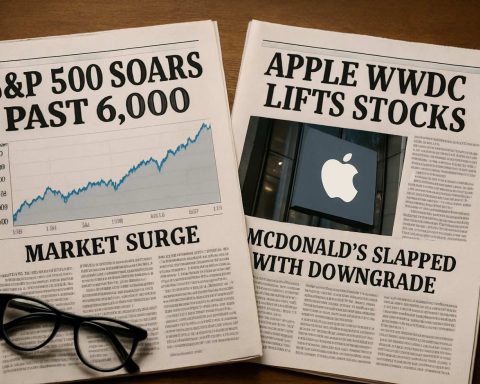- China’s tech giants—Baidu, Alibaba, Tencent, and Xiaomi—are rapidly growing, with their market cap doubling to $1.6 trillion.
- The U.S. tech sector, including the “Magnificent Seven,” has lost $3 trillion in value, with Tesla’s stock dropping over 35%.
- Alibaba leads China’s tech resurgence, increasing its value by 70% and generating significant investor interest.
- U.S. equities continue to attract investment with $123 billion in inflows, despite Chinese equities experiencing $14.9 billion in outflows.
- China’s market performance outpaces the U.S., trading over 20% above its 200-day moving average compared to the U.S.’s 2% growth.
- Financial analysts predict a shift towards international investments by 2025, focusing on markets like China and Europe.
- The current market environment emphasizes the importance of diversification and exploring emerging global opportunities.
China’s tech landscape is shimmering with success, its leading companies embarking on a meteoric ascent that has captured the attention of investors worldwide. Baidu, Alibaba, Tencent, and Xiaomi—an ensemble known as China’s Fabulous Four—are rewriting market narratives by doubling their market cap to an eye-popping $1.6 trillion this year.
In stark contrast, the much-celebrated U.S. tech companies are enduring a tempestuous ride. Dubbed the Magnificent Seven, these American giants have collectively shed $3 trillion in value. Tesla particularly finds itself at the heart of this downturn, seeing its stock tumble more than 35% year-to-date. Still, there’s a glimmer of resilience in Meta Platforms, which managed to climb over 7% amidst these challenges.
Alibaba has emerged as the leader in China’s tech resurgence, soaring an astounding 70% and spearheading a rally that has analysts and strategists abuzz. Yet, despite the setbacks facing U.S. tech, American equities retain their magnetic pull, with capital inflows standing robust at $123 billion this year. In contrast, Chinese equities have experienced outflows totaling $14.9 billion.
Even so, the technical indicators tell a different story; China’s market is outpacing its U.S. counterpart, trading more than 20% above its 200-day moving average. By comparison, the U.S. market’s uptick sits just over 2%. This disparity suggests a growing confidence in the stability and potential of Chinese stocks.
Financial experts like Bank of America’s Michael Hartnett forecast 2025 as a turning point, hinting at a shift towards international investments. He points to potential geopolitical tensions and transformative policy shifts as ripples that could redirect capital flows from U.S. shores to vibrant markets like China and Europe.
As global dynamics evolve, the narrative playing out in stock markets underscores a key takeaway: diversification may now be more critical than ever. Investors eager to capitalize on emerging opportunities must look beyond familiar frontiers, considering the promising yet complex landscapes abroad where innovation and growth appear unyielding.
China’s Tech Surge: What This Means for Global Investors
The impressive rise of China’s tech giants—Baidu, Alibaba, Tencent, and Xiaomi—signals not only a compelling shift in the global investment landscape but also an opportunity to reevaluate diversification strategies. Known as the “Fabulous Four,” these companies have seen remarkable growth, doubling their market cap to $1.6 trillion in just a year, starkly outpacing their U.S. counterparts, the “Magnificent Seven,” who have collectively lost $3 trillion.
Why Are China’s Tech Companies Thriving?
1. Regulatory Environment: After a period of regulatory crackdowns, the Chinese government has dialed back its stringent measures, providing a conducive environment for tech companies. This has restored investor confidence, facilitating growth.
2. Innovation and Expansion: Companies like Alibaba have expanded beyond traditional e-commerce, venturing into cloud computing and digital payments, offering investors a more diversified portfolio of services.
3. Technological Advancements: China’s emphasis on artificial intelligence, 5G, and fintech has positioned its tech sector as a leader in innovation. This focus not only bolsters domestic growth but also increases global competitiveness.
How Global Trends Are Shaping Investment Strategies
Geopolitical Tensions and Policy Shifts
Financial strategist Michael Hartnett from Bank of America predicts that geopolitical tensions and potential policy changes could pivot capital investments from traditional U.S. markets to vibrant ones like China and Europe. These geopolitical dynamics, combined with China’s tech innovation momentum, could lead to increased international investments by 2025.
Market Performance
The performance indicators speak volumes: Chinese markets are trading over 20% above their 200-day moving average, while the U.S. market rests slightly above at just over 2%. This disparity hints at a growing confidence in China’s market stability and potential trajectory.
Exploring Diversification: A Key to Investment Success
Real-World Use Case: Alibaba’s Growth Story
Alibaba’s 70% stock surge exemplifies how diversification and adaptation can lead to substantial gains. Its transition into cloud services and digital ecosystems illustrates how diversified service offerings can mitigate risk and seize opportunities in volatile markets.
Actionable Investment Strategies
1. Broaden Your Portfolio: Investors should consider international equities to balance potential risks associated with single-market dependence. This approach not only mitigates risk but also taps into global growth pockets.
2. Focus on Technological Advances: Pay attention to sectors driven by innovative technologies such as AI and 5G, which are likely to lead future market expansions.
3. Monitor Geopolitical Developments: Keeping an eye on policy changes and geopolitical tensions can provide critical insights for timely investment decisions.
Market Forecasts and Trends
Looking forward, as technology continues to evolve and markets adjust to global economic shifts, staying informed about changes in regulatory environments and emerging technologies will be essential. The continued rise of Chinese tech companies may lead to intensified competition, encouraging companies worldwide to innovate further.
For more insights into the evolving tech market landscape, consider visiting Bloomberg for the latest financial and market news.
In conclusion, as the fabric of global tech investments becomes more intricate, the importance of diversification and strategic foresight cannot be overstated. By exploring emerging markets and leveraging technological advancements, investors can capitalize on burgeoning opportunities and ensure resilient portfolios amidst changing market dynamics.











